June 13th!
It’s the day Real Madrid fans, players, coaches and staff have looked forward to for months. In just nine days, Los Blancos will restart their season and pursuit of the La Liga crown.
A lot has happened in that time. First, Eden Hazard and Marco Asensio are nearly fit and plan to factor into the stretch run. Secondly, tired legs have had a long-needed rest, especially for those who represent their respective national teams. This is the longest break they’ve had in years. Finally, the stoppage presented an opportunity for Zinedine Zidane and the coaching staff to look deeply into the issues the squad was having in the build-up to the break.
In this scout report, we’ll revisit some of those issues, as well as some of the strengths, the club experienced leading into the break. A tactical analysis of starting XI options, attacking issues and the strength of the team, their defensive tactics, will shed light on what we can expect as paly resumes.
Finding the right starting XI
Zidane’s first task is finding the best-suited starting XI. With most, if not all, of his side available for the first time this season, he has some big choices to make. Some players have surely earned his trust, such as Karim Benzema at centre-forward, Sergio Ramos and Raphael Varane as the centre-back pairing and the deep-lying midfield combination of Casemiro and Toni Kroos. Unless he needs a rest, pencil Dani Carvajal in a right-back.
Near the end of play in March, we saw Marcelo and Vinícius Júnior earning regular playing time on the left. That’s a pairing I support, which I will discuss later in this analysis. The other two positions that will cause Zidane headache are the right-sided central midfielder and right-forward. The former is likely the easier of the two. He seems to have a matchup preference for Luka Modrić and Federico Valverde.
However, the right-forward position is a problematic spot for the club. Gareth Bale’s production has tanked this season, Rodrygo’s hot start has lost its spark and Isco doesn’t bring the qualities that Zidane wants in a right-forward. He could very well earn the nod, combining with Modrić and Valverde to unbalance opponents, but it’s a far cry from prime Bale.
Though Vinícius Júnior has earned most of the latest starts at left-forward, Hazard and Asensio are due to return to the lineup, throwing his role in doubt. While Asensio will need time to regain form after nearly a year off, Hazard, the big summer transfer, is bound to take the lion’s share of the minutes, provided he’s healthy.
Below, Vinícius Júnior’s heat map gives a very accurate idea of his playing style. He’s most comfortable providing width, often taking up the left-most position on the pitch, then using his pace to turn the corner on his defender. The red area highlights his most common starting point upon receiving the ball. The width offers isolation against his defender, giving Vinícius Júnior’s the time and space to run at his defender and win the duel.
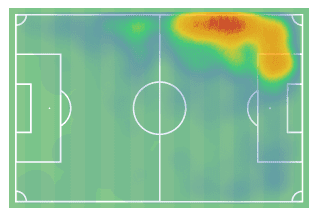
Contrasting Vinícius Júnior’s heat map to Eden Hazard’s, just below, and it’s clear the Belgian enjoys the open spaces on the left-wing, but he’s far less likely to follow a specific pattern of attack. Covering far more ground with a burst down the wing and cuts to the inside adds a layer of unpredictability to his play. Whereas opponents expect Vinícius Júnior to receive at his feet and attempt to beat an opponent to the outside, Hazard’s us of space shows he’s comfortable in the more compact central areas.
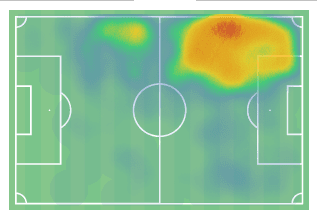
In terms of their dribbling usage, Vinícius Júnior ranks second to Lionel Messi in La Liga, averaging 9.67 dribbles per 90 minutes. Hazard is third overall, going to the dribble 9.22 times per 90. Despite the similar numbers, Hazard’s 58.2% success rate far exceeds Vinícius Júnior’s mark 49.5%. Hazard’s willingness to go inside or out factor’s heavily into that difference. Despite the difference in dribble success, Vinícius Júnior’s does own the advantage in xG per 90, beat the Belgian 0.3 to 0.11. Neither has finished well this season, but the youngster is at least finding better shooting positions.
Even if Hazard is currently the better player, rotation will be key in this crammed schedule. Ideally, when Hazard plays, Ferland Mendy’s preference for the wing offers a nice compliment. On the days Vinícius Júnior gets the start, Marcelo makes more sense at left-back. Since the younger Brazilian has a heavy preference to work in the wing. Marcelo’s underlapping can help unlock defences. Plus, it keeps the elder Brazilian more narrow, limiting the distance he needs to cover.
Rotation will be a hot topic around the league, but no team is better equipped for it than Real Madrid. With the chaotic schedule to end the season, I imagine Zidane and his staff already have a good idea of which combination of players will start in each match. Rotation will be necessary to keep players healthy, so this is an area we will track closely as the first few matches are played. Watching for starting XI trends or pairings will offer a nice element of tactical intrigue.
Solving the attacking issues
When we left off, Madrid was in the midst of an attacking slump, at least by their lofty standards. As detailed in other writings, especially in the Total Football Analysis magazine, the attack had become too predictable. On too many occasions, Madrid was missing a connection in attacking movements from the forwards. As one dropped or moved wide, his teammates were slow to pick up on cues or miss them entirely. In the end, many attacks were played out in front of the opposition’s backline with little threat to run behind.
Breaking the season into two portions, the second starting with Benzema’s slump in December, we see that Real Madrid has greatly underperformed their hot start to the season. Hazard’s frequent injuries have no doubt played a role. With him in the side, Los Blancos have an xG of 32.32, which is 2.15 xG per 90 minutes. If you take away his first four matches, that already impressive number skyrockets to 2.46 xG per 90. His influence is undeniable and absences deeply impactful.

In the home La Liga leg against Real Sociedad, the trio of Bale, Benzema and Hazard showed excellent understanding of each other. One thing that was noticeable, and is quite common when Madrid attack, is that the four highest attackers pair off. Benzema will more frequently slide to the left half-space to link up with the left-forward, whereas the right-sided midfielder moves high into the right half-space to offer support for the right-forward. That played out in the example below, with Carvajal and Casemiro offering deeper support. As the side played out of the back, Varane split the defence, finding Bale high up the wing. Note the positioning of Isco, Carvajal and Casemiro between the two clusters of Sociedad defenders. Their position offers a line-breaking pass and commands the attention of the defenders behind them, who, in turn, lost track of Bale.
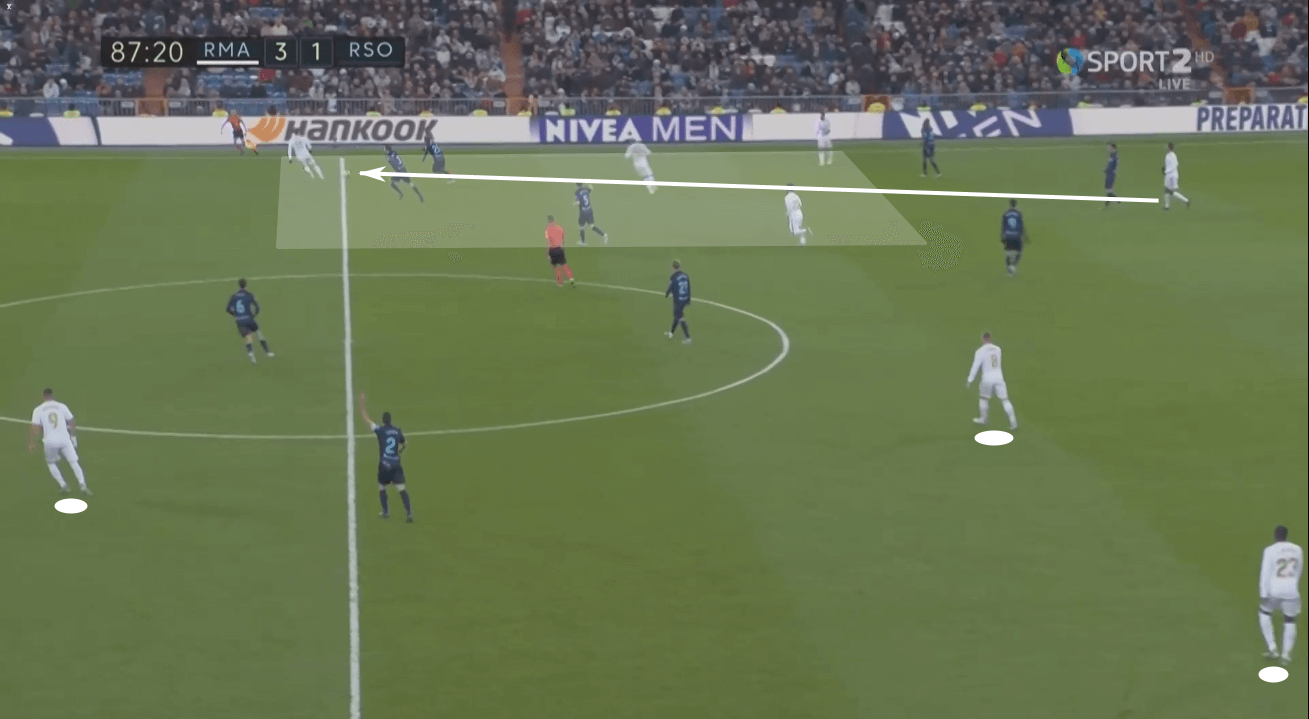
As Bale progressed into the attacking third, that left-sided partnership remained intact. On the right, Isco made a run behind the line and the remaining Madrid attackers positioned themselves beyond the low block, offering outlets, as well as inviting the defence to step higher, which would then unlock the space behind them.
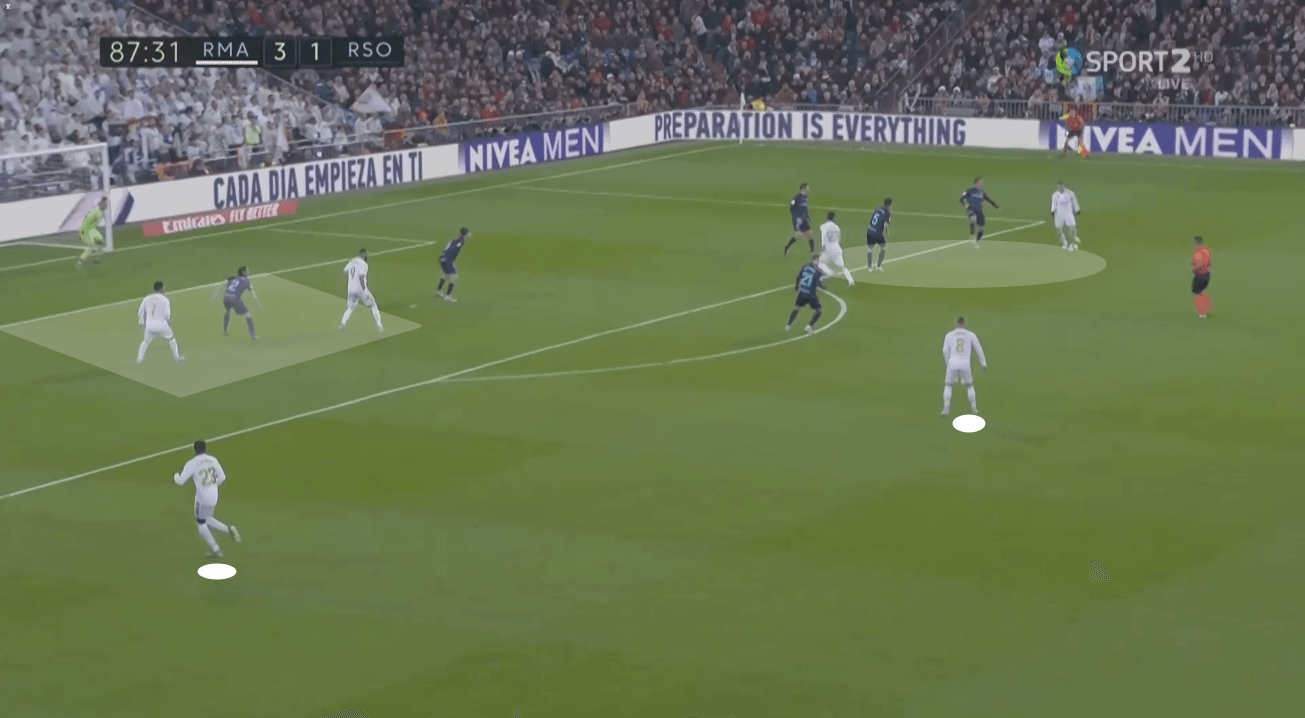
Though Real has a clear structure in place, at times it looks too rigid, making it predictable for the defence. Like most power-houses, they come across a lot of low blocks, making it really difficult to find space for penetration. Without a player like the departed Cristiano Ronaldo, the side does lack aerial strength on the frontline. Benzema and Bale are the only two in the group who offer much in the air, but the Frenchman hasn’t received the necessary service and the Welshman hasn’t seen the field much.
Attacking the backline early in a sequence, be it through the pass or dribble, would benefit this group of players. When they do have space to counterattack, they must take advantage of the available space and their qualitative advantages.
El Clásico offered a situation of this sort. Marcelo’s pass to Benzema was controlled by the Frenchman. Samuel Umtiti was man-marking at the time and chased him into the space just in front of Gérard Piqué. With the Spaniard holding a deep line, Vinícius Júnior had room to run behind the defence. Benzema played him through, but, with the undeveloped chemistry between the two, the run was a fraction of a second late and the pass was a bit too forceful. Vinícius Júnior did collect the ball, but well into the wing. Nélson Semedo caught his counterpart, putting in a strong tackle to kill the attack.
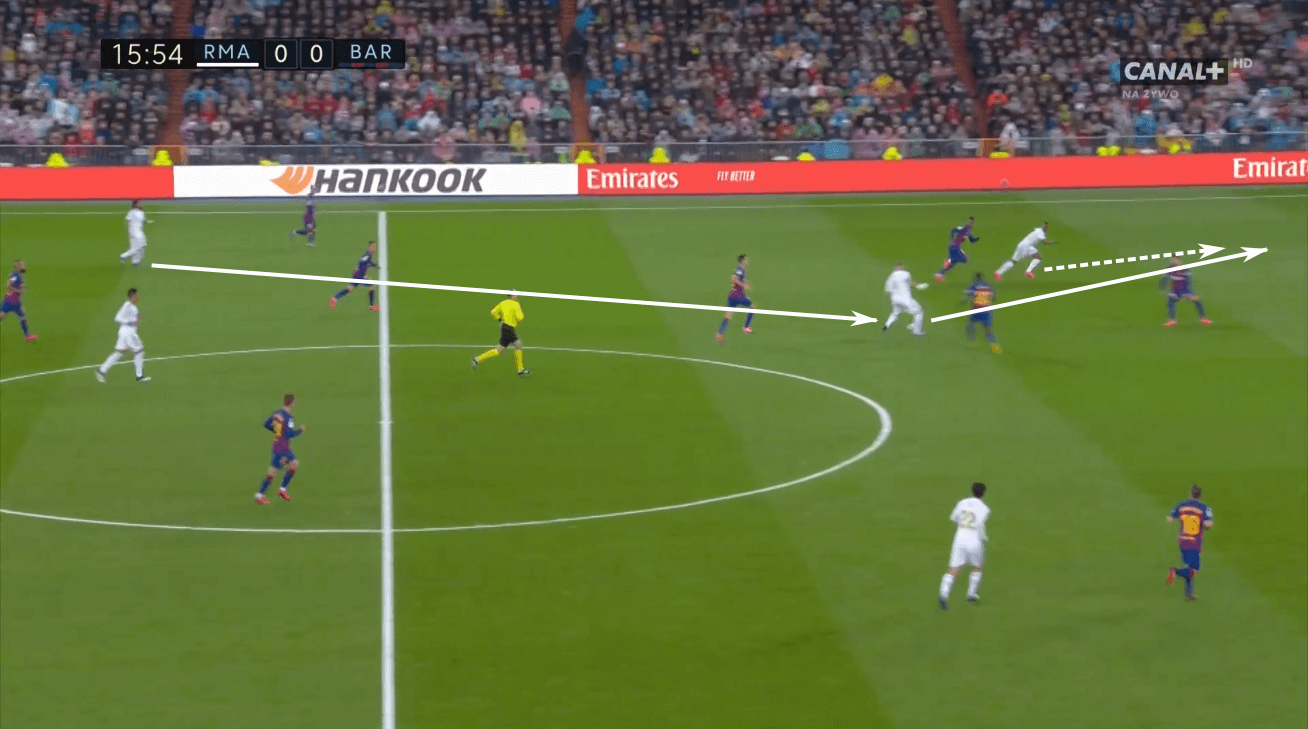
That lack of understanding does pose a problem for Zidane, one he’s surely spent the break evaluating. When Hazard has played, he and Big Benz have shown a strong connection. With the two world-class players maintaining a close positional relationship, they have worked off of each other really well, showing a mutual desire to attack the half-space.
Below is another example from that Real Sociedad match. With Ramos on the ball, Hazard and Benzema occupied the left half-space, cueing Mendy to move into a high and wide position. Ramos’ chip finds him, initiating an attack on the right side of Sociedad’s defence.
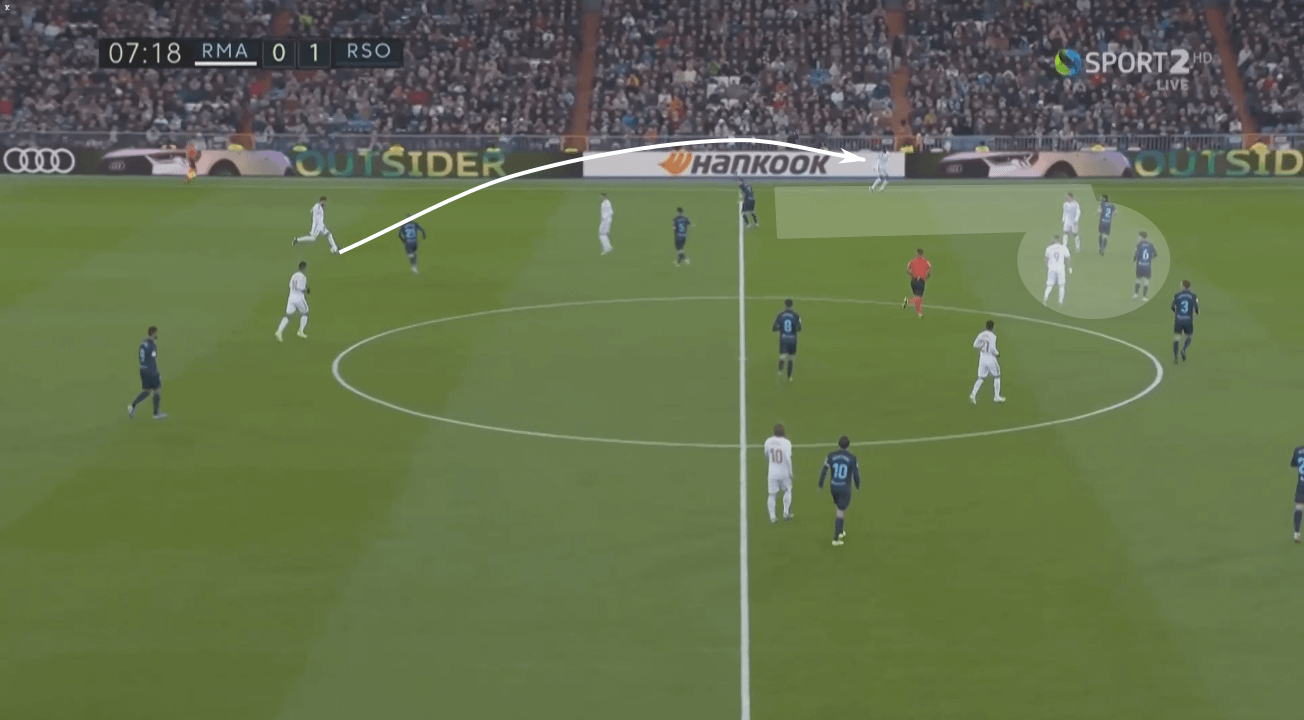
A quick combination saw Hazard play Mendy down the touchline. As the trio raced down the pitch, Mendy slowed down, cueing Hazard to make his run behind the defence. To facilitate the run, Benzema dropped into Hazard’s space, preventing the right centre-back from following the Belgian. As the defender stepped forward, Benzema played a through pass to his teammate.
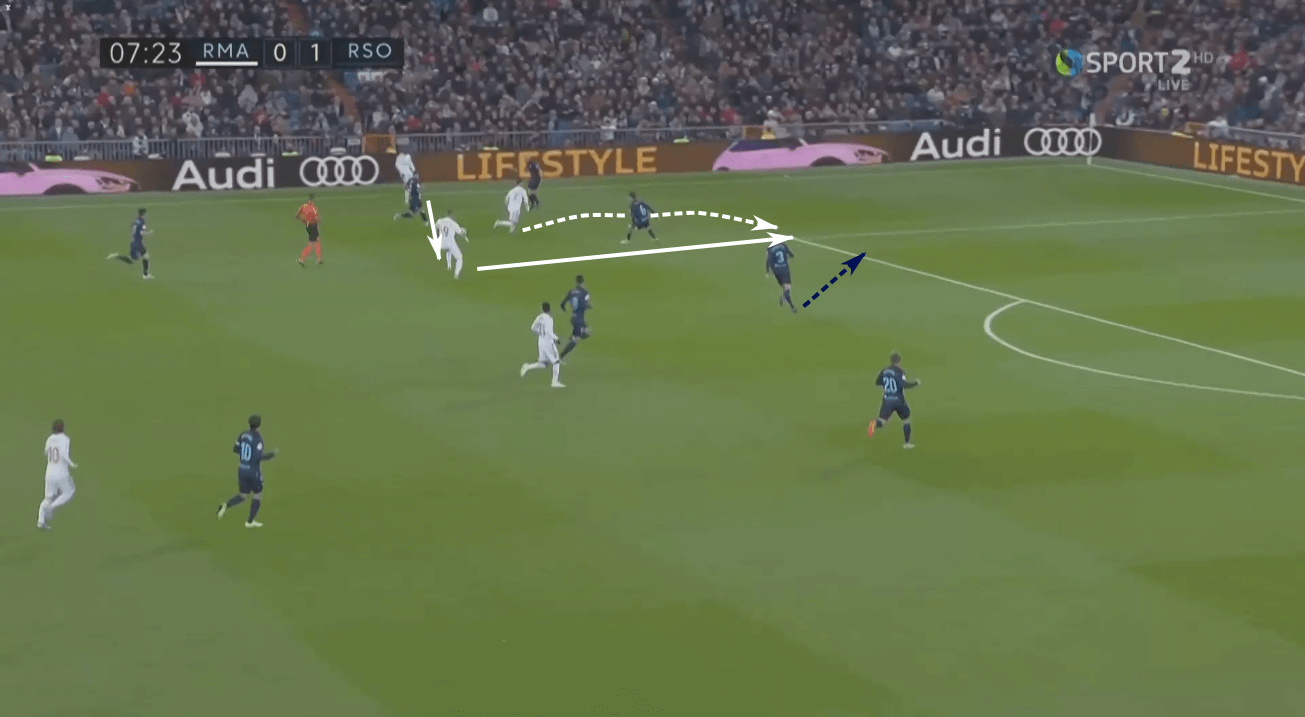
With only Diego Llorente to beat, Hazard made a quick move, beating the Spaniard to the outside. The touch was heavy, taking him to the endline, but Hazard regained control, cut inside and rifled his shot into the side-netting.
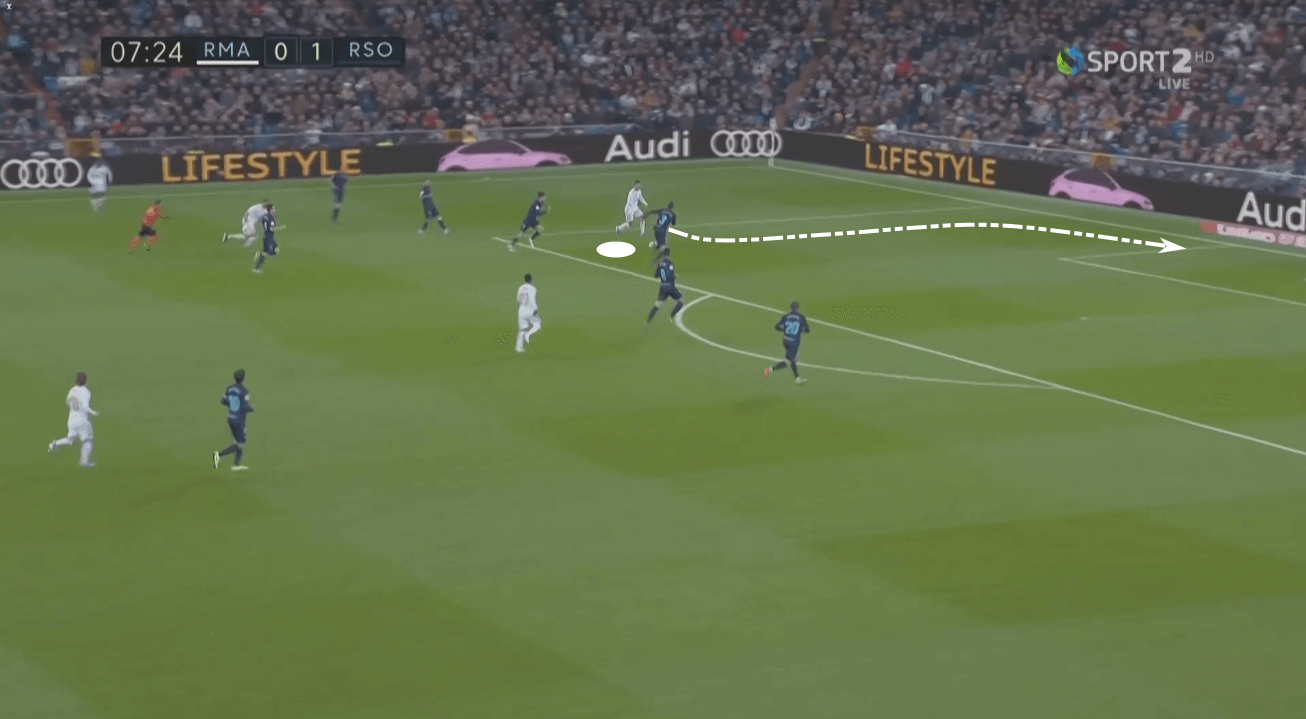
The chemistry of Hazard and Benzema was on display roughly 20 minutes later, this time through the dribble. Knowing that his teammate prefers to cut inside to shoot with his right foot, he understood that he needed to drag the holding midfielder, Igor Zubeldia, away from that space. Benzema made a decoy run, pulling the defender out of that space and allowing Hazard to cut inside and take a shot.
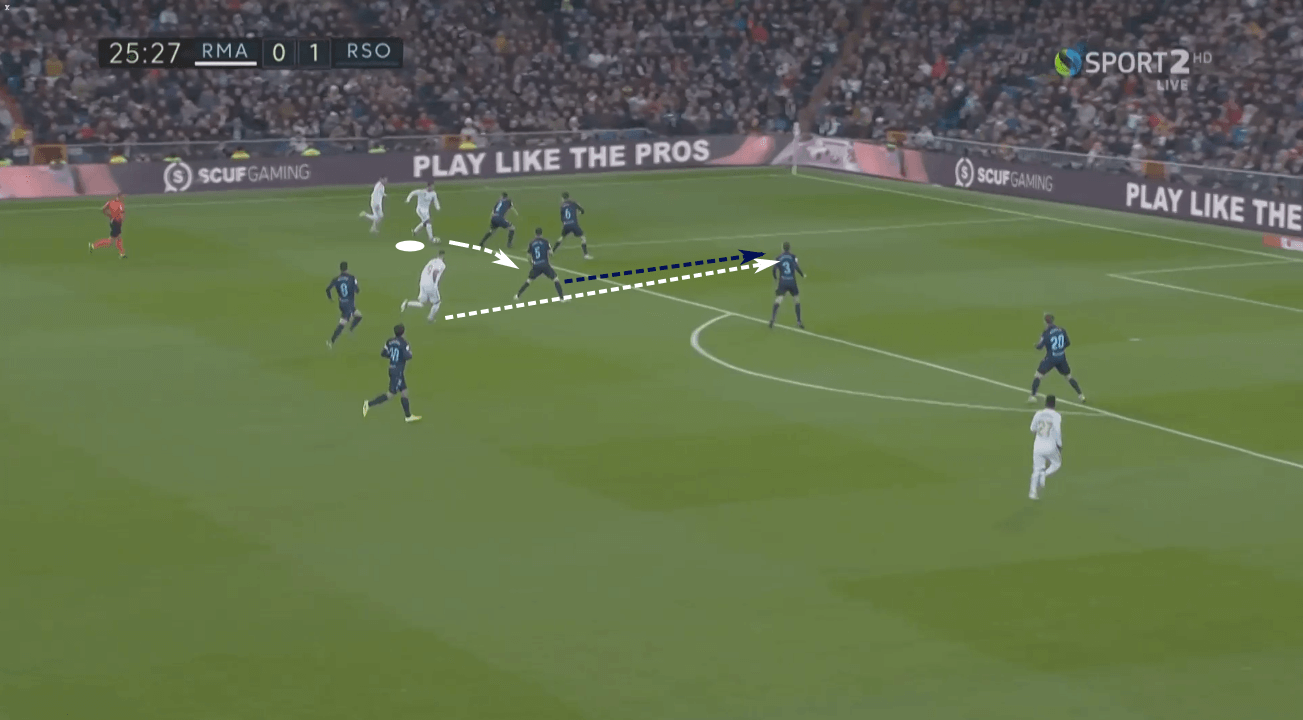
Though Real Madrid have the deepest roster in La Liga, the absence of Hazard has hurt both the team and Benzema. If the Belgian is fully recovered from his injury during the stretch run, he’ll bring a big boost to the attacking production of the side. His deceptiveness in the final third is the piece of the puzzle that was missing during the last few months of play. When he does start, expect greater production from Benzema and more goals from the team.
Maintaining the defensive foundation
Not only does Real Madrid’s 19 goals conceded lead La Liga, but it’s the lowest number of goals against in all of Europe’s top five leagues. This mark isn’t down to luck. Los Blancos also own the mark for the lowest xGA (expected goals against) at a paltry 21.94, equating to 0.81 xGA per match. Zidane’s work here is a masterpiece, especially given the leaky defence of the previous season’s squad.
At the core of this regained defensive strength is the deep quadrilateral of Casemiro, Kroos, Ramos and Varane. With Kroos operating as a left-sided regista and Casemiro roaming the right half of the pitch, the four form a virtual square to deny central penetration and protect against the counterattack.
In the derby against Atlético Madrid, Real found themselves attacking against a low block. As the ball came outside of the block to Kroos, it was deflected and won by former Madridista, Álvaro Morata. As Atléti set off to counterattack, Real Madrid was fully prepared to handle the threat.
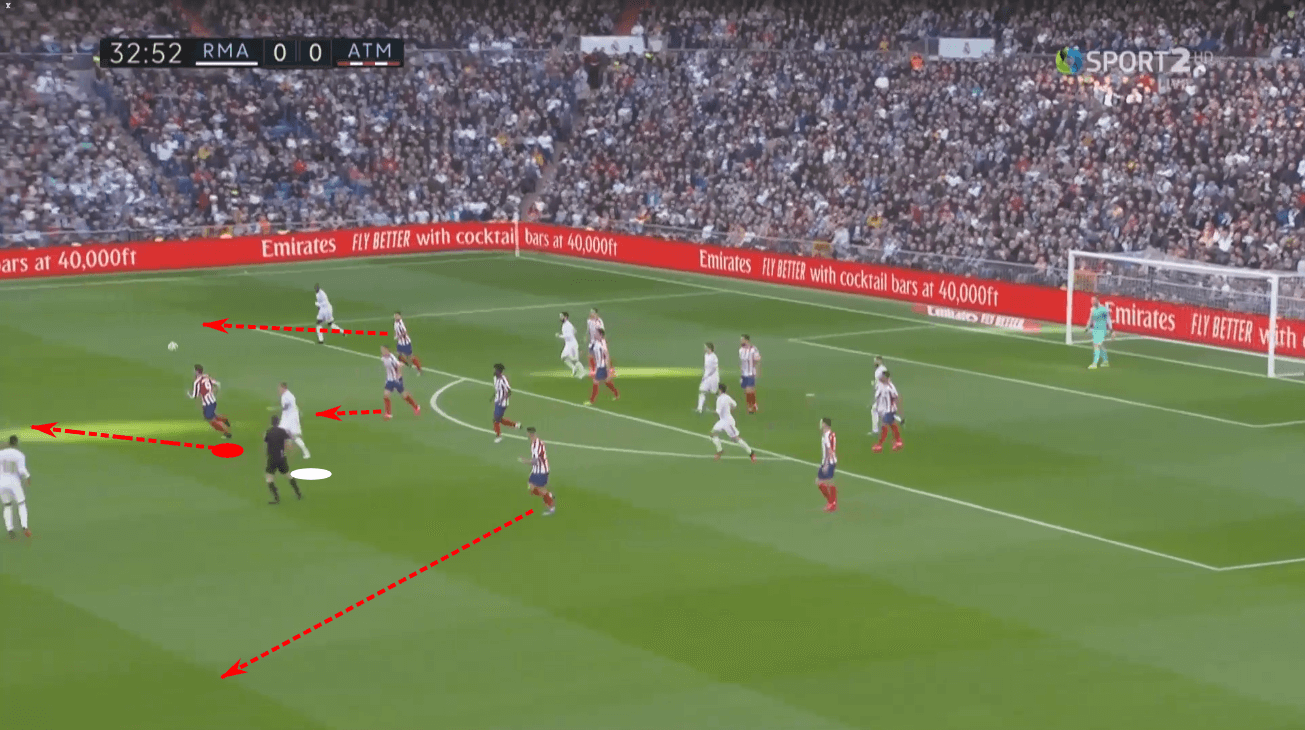
In the image below, Casemiro, Ramos and Varane are behind the ball and Kroos is in line with it. Those four are almost always behind the ball. A virtual square in the centre of the pitch eliminates penetration through the central channel. That forces the opponent wide, giving the rest of the team time to recover their ground. Atlético have just one player on their left-half of the pitch, but the run of Morata and recovery of Carvajal ensure he’s not a threat. Varane is also ready to unleash his rocket-propelled boots to cut out any passes over the top. Ultimately, this attack ended with Morata taking the ball out of bounds due to Ramos’ pressure.
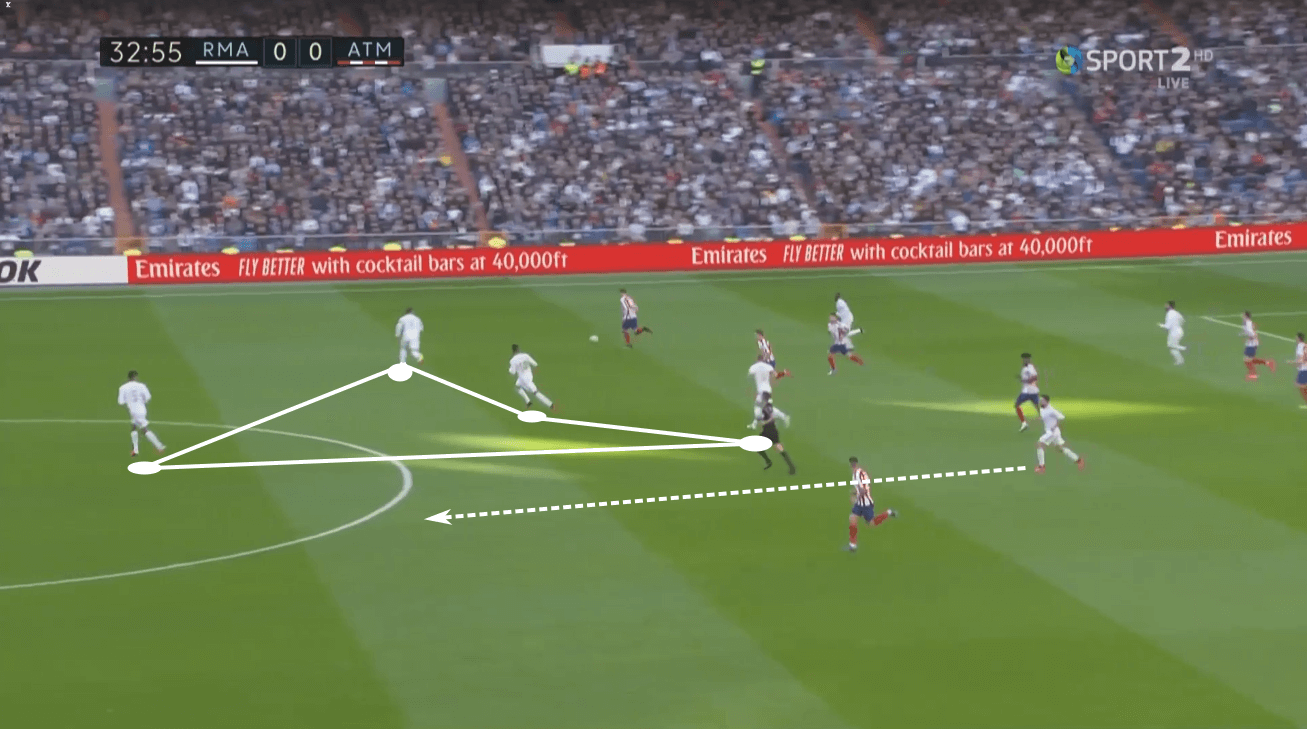
The deep, central square gives Madrid the opportunity to take more chances higher up the pitch, both in attack and defence. From an attacking perspective, the result is pushing the outside-backs, particularly the left-sided back, higher up the pitch to provide width. The third midfielder also has the freedom to operate as more of a #10.
As the ball is turned over, Madrid benefit from having significant numbers available to counter-press. When they can win the ball, they will certainly accept it. However, they’re not a side that overcommits in the counter-press. Instead, the priority is to deny entry to a high outlet and attacking the space between the holding and attacking midfielders. Once that is in place, the first defender presses while his teammates move to the nearest mark.
This was on display against Barcelona. As Madrid turned the ball over, Arturo Vidal carried the ball forward under heavy pressure before laying it off to Antoine Griezmann. The pass was behind the Frenchman, forcing him to play backwards. He had no choice but to play backwards, allowing Real Madrid to finish collecting their man-marking assignments.
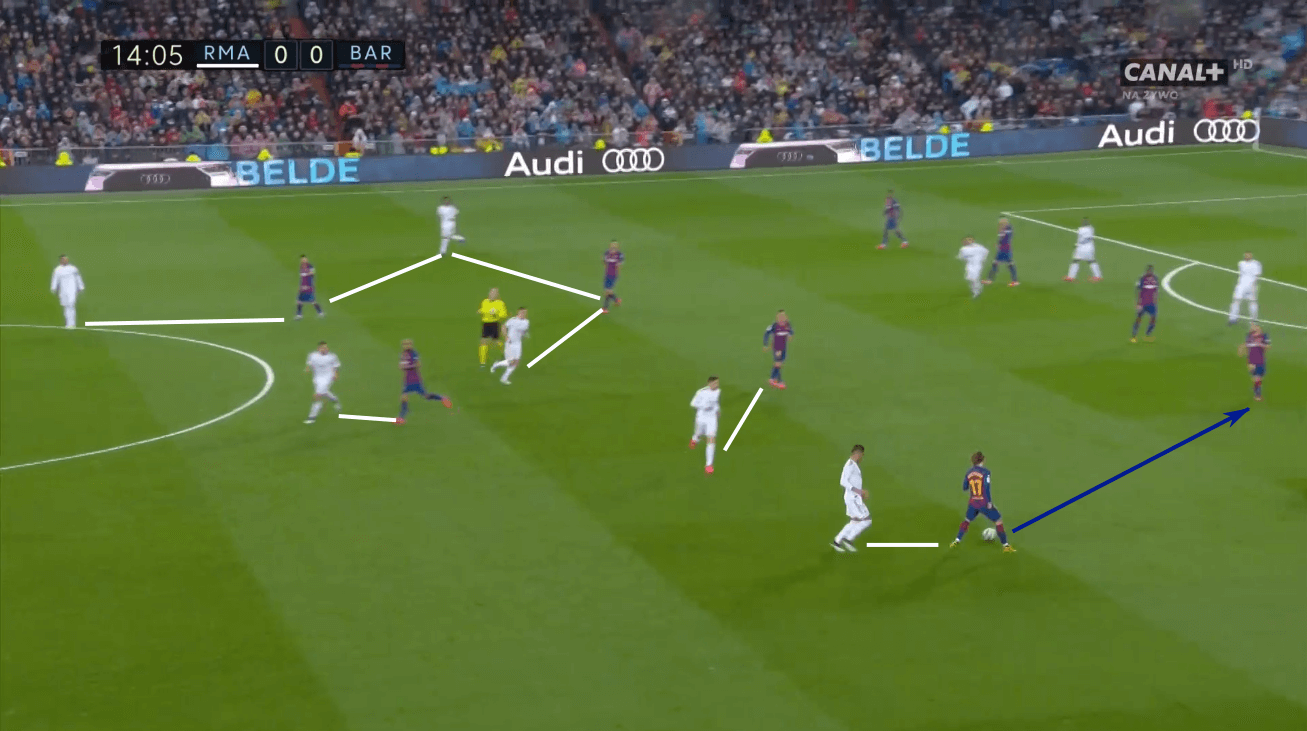
As you can see, 19 seconds pass before Barcelona is forced into action. Even though they held the ball for such a long stretch, Real’s defending forced them back with nearly every other pass. Finally, Umtiti had no choice but to play laterally to Marc-André ter Stegen. That released Benzema to pressure the keeper while cutting off the passing lane to Umtiti, forcing ter Stegen to play long.
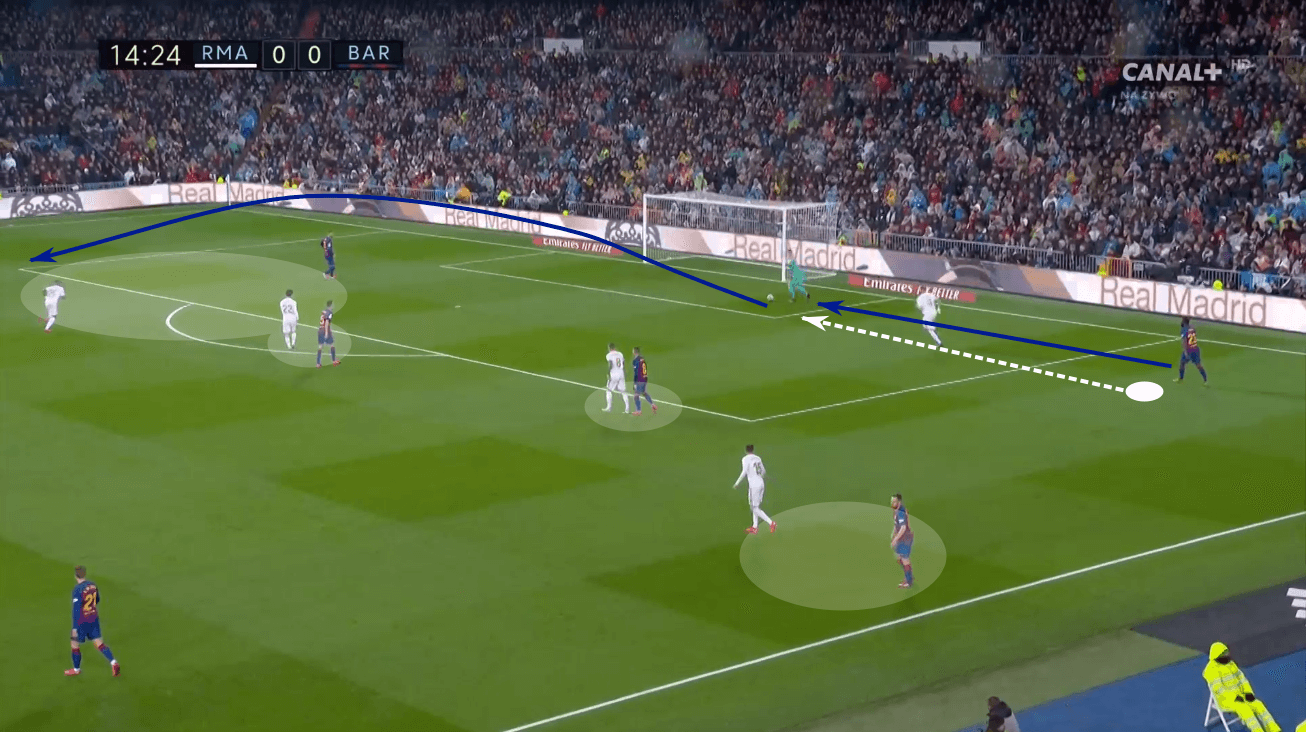
His delivery is won by Casemiro. The resulting header to Marcelo relaunched the Madrid attack, this time with Barcelona is a more expansive attacking shape.
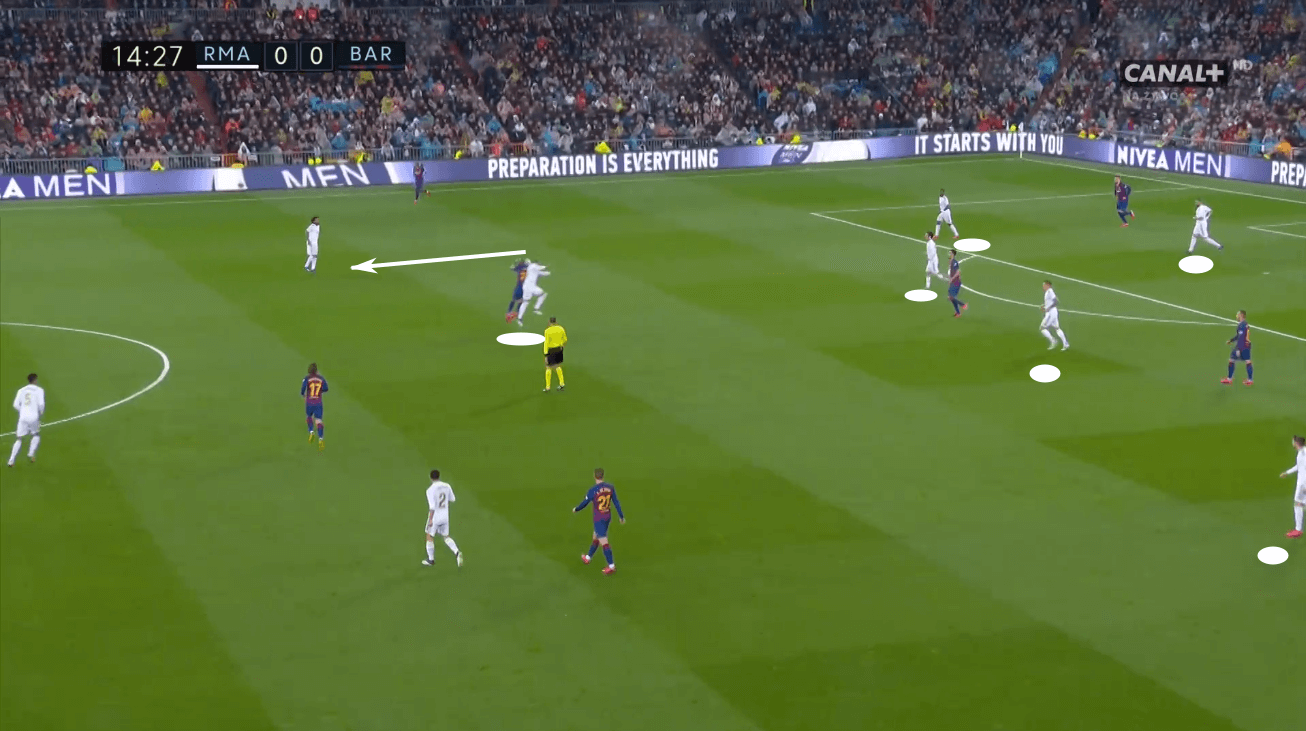
Los Blancos have used this man-marking system well this season. For a deeper analysis of man-marking tactics, be sure to check out my article in the Total Football Analysis March 2020 magazine. The execution of the system has not only provided defensive stability, but it has opened up better attacking opportunities as opponents are gradually moving into wider areas to break the press and assume an attacking structure. Their movement is Real Madrid’s gain.
Conclusion
Sitting just two points behind Barcelona, this La Liga title race promises to be a close one. With a healthy squad at his disposal, Zidane has the depth of personnel to overwhelm opponents with fresh legs and the right tactical matchups. If the tactics are right and his players enter play with the right mindset, expect them to produce an excellent run of form and keep the pressure on Barcelona.
As we’ve seen in the Bundesliga, the depth of the top teams has frequently carried them to big results over smaller clubs. Expect Zidane to start his top players for the first match, then rotate as many as four or five players from one match to the next to ensure a fit squad and physical dominance.
Tired of commentary which tells you nothing new about the action in front of you? Well, we’ve got a solution. We’ve partnered with HotMic to provide live commentary and analysis of the best football action from around the world, and we’re covering some of the best matches in the Bundesliga this weekend! Download the HotMic app and sign up using the code ‘TFA2020’ to keep up-to-date with all our coverage – we’ll be covering the Premier League, La Liga and Serie A as well when they resume, so make sure to follow us on the app, and get in-depth analysis and tactical knowledge from the best analysts in the business!
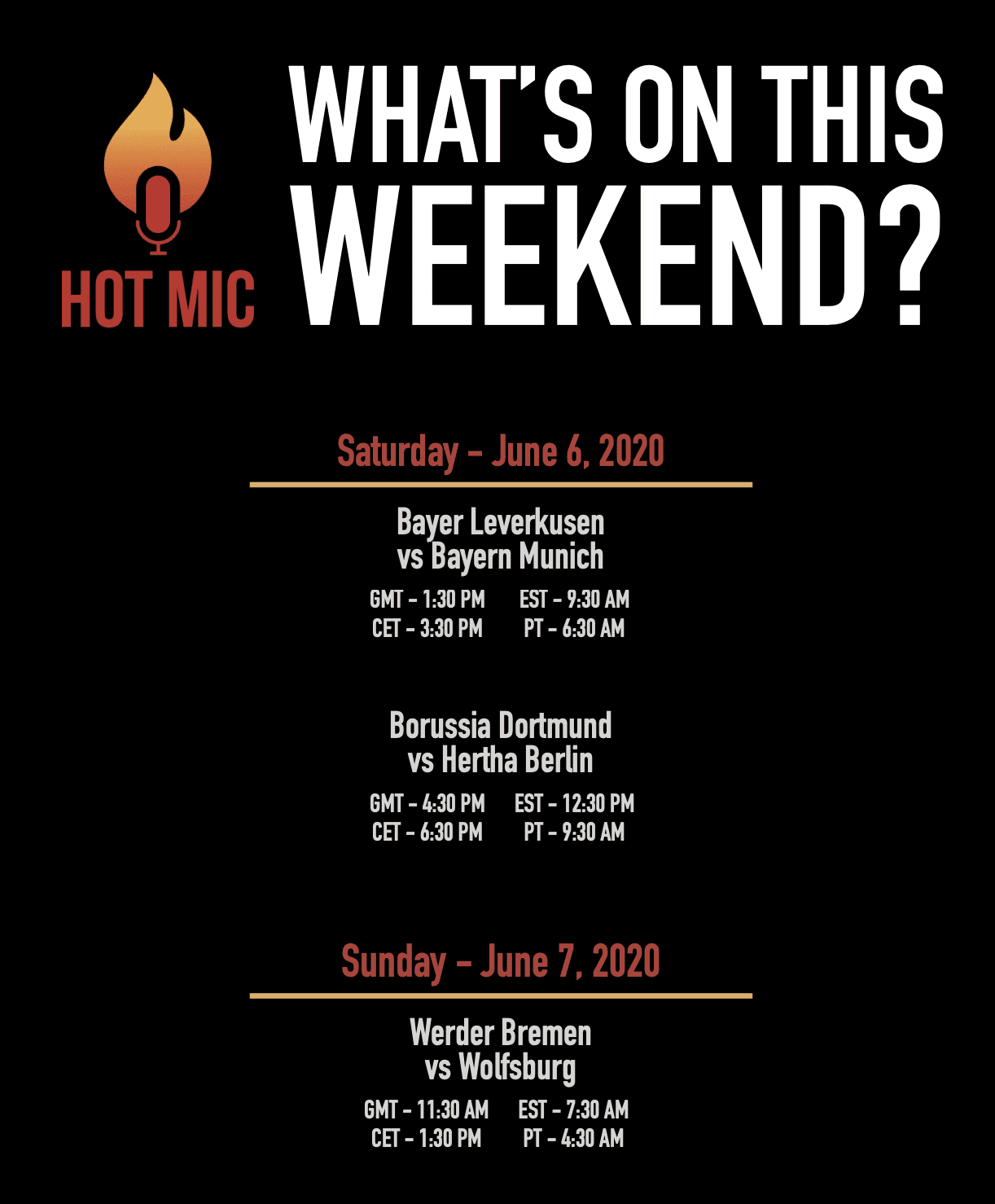




Comments